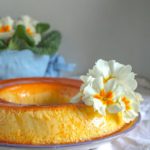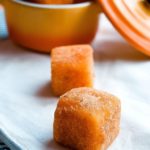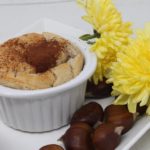IMPERIAL MILK! THE FESTIVE DESSERT

This Imperial Milk is a family recipe and originates from what Italians traditionally call “Portuguese Milk” or what is more internationally known as “crème caramel”. It goes by different names and is very common in all Western cuisines.
The ingredients are simple: eggs, sugar, milk, vanilla combined in a pleasant dessert, which is given a unique touch thanks to the addition of finely ground almonds and Amaretto cookies. This finishing touch was conferred by my great-grandmother who used a coal burning range. She had to perfectly regulate the coal inside the oven and cooked the Imperial Milk by placing burning embers on the mould’s metal lid.
This dessert was extremely popular in European restaurants during the last decades of the twentieth century, probably due to the convenience for restauranteurs, who could prepare it quite in advance and to keep it until clients requested it.
The basic ingredients of this recipe bring back the use of eggs and milk, combined to make use of what were considered medicinal virtues of eggs since ancient times. During the Middle Ages these ingredients were appreciated because of the need to eat meatless alternatives during fasting periods, especially during Lent. Nevertheless, in Spanish-speaking countries, the attention is focused on the eggs, “flan de huevo” or more simply “flan”, and not on the milk.
Prep Time: 30 minutes | Cooking Time: 1 hour + 5 minutes | Total Time: 1 hour + 35 minutes | Yield: Makes 8 servings.
Ingredients
- 4 cups whole fat milk
- ½ cup Peeled almonds
- 4 Amaretti cookies
- ½ cup white sugar
- 7 medium eggs, room temperature
- 1 vanilla bean
- For the caramel
- 1 tablespoon water
- 1/3 cup white sugar
Instructions
Bring milk and vanilla to boil in light medium saucepan. Remove from heat and let it cool down.
Pour the almonds in a baking pan, on parchment) and bake it in a pre-heated oven for 10 minutes at 350 F (180 C) – until pale gold. Let them cool down.
Pour the ingredients for caramel directly in the mold. Protecting your hands with gloves, put the mold over low heat and dissolve the sugar in it. Increase heat to medium-high and bring mixture to boil. Boil without stirring until mixture turns deep golden brown, swirling pan occasionally. Carefully tilt mold to coat bottom (not sides) with caramel.
In a grinder, pour the almonds, the Amaretti and 1 tablespoon of sugar and grind the mix, until it turns into a powder.
With an electric mixer, whisk the eggs and the rest of the sugar until pale. Add the mix of powdered almonds and Amaretti, and the milk through a sieve. Pour the custard in the mold you have prepared.
Place the mold in a baking pan and add enough hot water to it to come halfway up sides of mold.
Bake at 320 F. (160 C) for 1 hour and grill for 5 minutes at 400 F (200 C).
In the case of the Italian Milk Portuguese style, the mould is covered by a lid in order to keep the top of the custard soft. In this case, the almonds and cookies must raise to the top and form a crispy crust.
Run a small sharp knife around edge of custard to loosen. Invert custard onto plate and serve.

